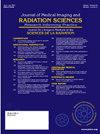使用 WB LGE(宽带晚期钆增强)序列为心脏植入电子装置(CIED)患者进行心脏磁共振成像(CMR)的实践经验
IF 1.3
Q3 RADIOLOGY, NUCLEAR MEDICINE & MEDICAL IMAGING
Journal of Medical Imaging and Radiation Sciences
Pub Date : 2024-10-01
DOI:10.1016/j.jmir.2024.101475
引用次数: 0
摘要
有条件的核磁共振成像心脏植入式电子装置如今已变得越来越普遍,这使得带有这些装置的病人可以在适当的程序和监控下安全地接受核磁共振成像检查。CIED 不再是磁共振成像检查的禁忌症或安全问题。然而,植入 CIED 后的心脏病患者通常无法接受 CMR 检查,因为 CIED 及其导线会产生易感性和非共振伪影。这些伪影非常大,遮挡了心脏,使 CMR 几乎无法解读,尤其是后期钆增强。西门子引入了 WB LGE 序列,以减少该设备造成的易感性和非共振伪影。北大人民医院于 2023 年 6 月安装了该序列。对 2 名 CIED 患者进行了 CMR 扫描。所生成的 CMR 图像质量令人满意。总之,为 CIED 患者进行 CMR 扫描具有挑战性,因为会产生与设备相关的伪影。通过使用 WB LGE 序列,我们可以减少由设备造成的伪影,从而生成具有诊断质量的 CMR 图像。本文章由计算机程序翻译,如有差异,请以英文原文为准。
The practical experience of performing cardiac MRI (CMR) for patients with Cardiac Implantable Electronic Device (CIED) using WB LGE (Wideband Late Gadolinium Enhancement) sequence
MRI conditional Cardiac Implantable Electronic Devices have become more common nowadays, which allowing patients with these devices to undergo MRI examinations safely with appropriate programming and monitoring during the procedures. CIED is no longer a contraindication or safety concern for MRI examinations. However, patients with heart disease after CIED implantation are usually not able to undergo CMR because of the susceptibility and off-resonance artefacts caused by CIED and its leads. The artefacts are substantial and obscure the heart which makes CMR almost not interpretable, especially late gadolinium enhancement. WB LGE sequence is introduced by Siemens to reduce the susceptibility and off-resonance artefacts caused by the device. NUH installed the sequence in June 2023. CMR scans were performed on 2 patients with CIED. Quality of the CMR images produced was satisfactory. In conclusion, performing CMR for patients with CIED is challenging because of device related artefacts. With WB LGE sequence, we can produce diagnostic quality CMR images by reducing the artefacts caused by the device.
求助全文
通过发布文献求助,成功后即可免费获取论文全文。
去求助
来源期刊

Journal of Medical Imaging and Radiation Sciences
RADIOLOGY, NUCLEAR MEDICINE & MEDICAL IMAGING-
CiteScore
2.30
自引率
11.10%
发文量
231
审稿时长
53 days
期刊介绍:
Journal of Medical Imaging and Radiation Sciences is the official peer-reviewed journal of the Canadian Association of Medical Radiation Technologists. This journal is published four times a year and is circulated to approximately 11,000 medical radiation technologists, libraries and radiology departments throughout Canada, the United States and overseas. The Journal publishes articles on recent research, new technology and techniques, professional practices, technologists viewpoints as well as relevant book reviews.
 求助内容:
求助内容: 应助结果提醒方式:
应助结果提醒方式:


